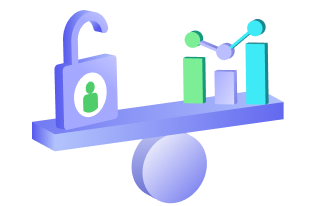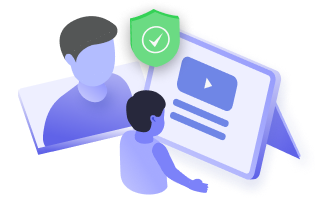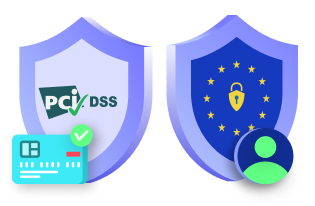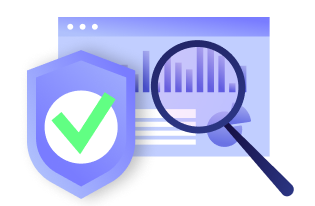Data-driven decision-making is essential for business growth. Companies that use data in their operations improve decision-making and innovation. However, concerns about unrestricted data collection and privacy are rising. As an ethical business, it is crucial to balance data analytics with privacy. This article explores how to achieve this balance.
What is data analytics and why is it important?
Data analytics refers to analyzing raw data to derive conclusions from it. Computer programs have automated many processes for data analytics to run on simple data without any human intervention.
Data analytics is essential for businesses because it enables them to make informed decisions based on insights gathered from data. By taking a data-driven approach, businesses can uncover new business opportunities, enhance customer service, and increase sales. Data analytics allows businesses to carefully analyze data and make decisions based on the insights gained. This approach helps businesses to reach their goals in a more efficient and effective manner.
What is data privacy?
Data privacy is a set of rules for the access or management of data in a way that doesn’t compromise the privacy of users. All confidential material businesses manage, including that of their clients, shareholders, and workers, are subject to data privacy issues. This data often has a crucial impact on corporate growth, management, and economics. Let’s look at a few solutions to protect data.
Some technologies and approaches that can ensure data privacy and protection are:
- Access control: Limiting access to protected data to authorized users ensures the minimum likelihood of data theft.
- Firewalls: Use firewalls to control access to data transmission, giving it only to authorized users by monitoring and filtering network traffic.
- Encryption: Data encryption employs techniques to protect the data by transforming it into an unintelligible format, requiring a valid key to decode it.
- Two-factor authentication: A system or service that requires two authentication elements. It ensures hackers can’t steal data, even if they get the passcode.
- Backup: Lessens the chance of primary data loss by making an identical duplicate of your content and keeping it in a safe place that only designated users can reach.
Data analytics in the age of privacy
Every day, the world generates massive amounts of new data. This makes it important to have tools for data analysis and retrieval or storage. Similarly, this also creates privacy problems, such as legal restrictions and the right way to use information.
The concept of privacy rights dates back to the nineteenth century. Legal pioneers, Samuel Warren and Louis Brandeis coined the term “right to privacy” in their 1890 law review article, intended to safeguard an individual’s “inviolate personality” against emerging technology.
The Role of The General Data Protection Regulation (GDPR)
The General Data Protection Regulation (GDPR) is a vital component in the digital privacy landscape. It is a European Union (EU) legislation that governs the collection and use of personally identifiable information from individuals, both inside and outside the Union. Its broad scope, encompassing a wide range of entities, made it occupy a prominent place in the privacy legislation landscape after it was approved in 2016 and went into effect two years later. By holding businesses accountable for managing and utilizing this data, the GDPR empowers customers to take control of their personal information, regardless of where the businesses are located. As a result, any website that attracts users from Europe must comply with GDPR, even if they do not specifically target EU citizens in their marketing of products or services.
When considering the impact of data privacy on any aspect, it is essential to prioritize the GDPR as one of the most crucial laws to adhere to. Check the detailed guide to help you understand the law and its requirements.
How does data analytics affect privacy?
The power of data analytics is so tremendous that, despite its advantageous economic opportunities, new privacy problems are constantly emerging. It is vital to understand these issues in order to solve them.
Here are some of the biggest threats to privacy posed by data analytics.
- Privacy breaches: Data analytics-driven operations for companies and other entities give them access to very sensitive information. This gives them the power to violate the privacy of individuals, causing humiliation and even financial losses.
- Impossibility of anonymity: If we do not establish guidelines for the use of anonymous data, advanced analytics may make it difficult to ensure that individuals cannot be identified through a large amount of data. This implies that even if data is labeled as anonymous, it may still be possible to identify people.
- Discrimination: Prejudice has always been a problem, but the concern is that using data analytics could make it worse. These analytics could make biased decisions if the data used to train them is biased.
- Unethical actions: Businesses can use data analytics to influence behavior, but they should be cautious about using this power unethically. Using big data analytics to make decisions without considering how it might impact the people involved is wrong. For instance, businesses may use data analytics to make commercial decisions that benefit them but could harm people in their daily lives. Therefore, companies should be careful not to abuse their power, and ensure they’re using data analytics responsibly.
- Inaccurate data: Data analytics can make accurate forecasts, but not always. If data analysis includes incorrect data about people, errors in data models, or poor algorithms, this can lead to inaccurate results. Organizations may make bad decisions that affect the privacy of users when they do not detect and validate these errors.
How to strike a balance between data analytics and data privacy
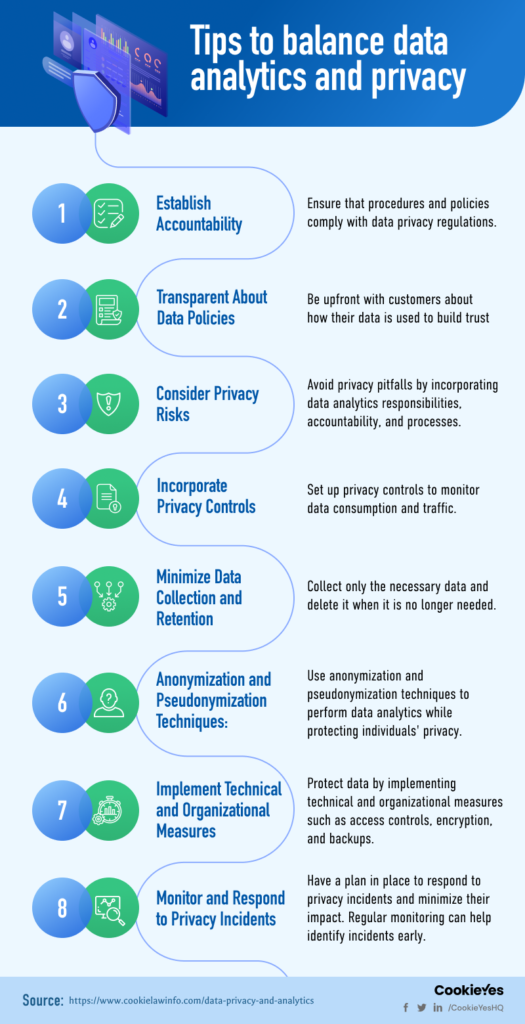
Let’s look at them in detail:
Establish accountability
Accountability is crucial to a company’s security approach regarding data privacy. To ensure that procedures and policies are defined, executed, and demonstrate compliance with tangible proof, you must use effective methods in your security project.
While businesses must follow certain accountability criteria, others go beyond what the law requires. By meeting these extra criteria, you could give your business a strategic edge and show customers how seriously you take data protection and privacy.
Be transparent about your data policies
There has never been a time when brand trustworthiness was more crucial for companies. Consumers have always been particular about the goods and services they choose.
If you wish to secure their information, you must be upfront with your customers about how you utilize their data. Do you want to enhance their encounter with your company, or do you intend to profit from it? Or maybe both?
For example, if a seller of custom products learns that you purchased a certain product, they might then use that information to advertise similar goods to you. While some customers might prefer this, such practices might annoy others, so it’s essential to allow them to have a say in the matter. This can resolve by implementing robust consent practices. Robust consent practices are essential for balancing data analytics and data privacy. Organizations need to seek informed consent from users before collecting and processing their data for analytics. Providing transparent information about the data being collected, its purpose, and how it will be shared is involved in this.
Analytics cookies pose a potential risk to privacy, given their ability to track user behavior on websites. Therefore, organizations must obtain explicit consent from users before deploying these cookies. The website must also provide users with the option to opt-out of analytics cookies and must respect their preferences.
Consider the privacy risks when planning data analytics strategies
When developing your big data analytics plans, keep in mind the privacy threats we just mentioned. Implement data analytics responsibilities, regulate accountability, rules, and processes, and utilize them to avoid pitfalls.
Incorporate privacy controls into processes before implementing them
To protect sensitive information, it’s important to be able to monitor and enforce compliance with policies. This can be done by setting up privacy controls that track data usage and make sure it’s distributed according to regulations. If something goes wrong, corrective action can be taken.
These monitoring systems should be able to identify unusual activity and stop any unlawful data transfer due to the massive amount of digital data being handled by companies. There are different software solutions that can be used to monitor digital communication channels and detect sensitive data.
Minimize data collection and retention
One way to strike a balance between data analytics and data privacy is to minimize the amount of data collected and stored. Collect only the necessary data and delete it when it is no longer needed. By reducing the amount of data collected and retained, you reduce the risk of data breaches or unauthorized access.
Use anonymization and pseudonymization techniques
Anonymization and pseudonymization are techniques used to protect personal data by making it difficult to identify individuals. Anonymization involves removing all identifying information from the data, while pseudonymization involves replacing identifying information with a pseudonym. By using these techniques, you can still perform data analytics while protecting individuals’ privacy.
Implement technical and organizational measures
Implementing technical and organizational measures ensures the protection of data throughout its lifecycle. This can include measures such as access controls, encryption, and regular backups. By implementing these measures, you can reduce the risk of data breaches and unauthorized access.
Monitor and respond to privacy incidents
Even with all the safeguards in place, there is always a risk of a privacy incident. It’s important to have a plan in place to respond to privacy incidents, including how to notify affected individuals and authorities. Regular monitoring can help identify incidents early and minimize their impact.
Key Takeaways
In conclusion, adopting a data-driven approach can give a company a competitive advantage by providing access to valuable operational data across all activities. However, the use of data analytics must be balanced with privacy concerns. Failure to appropriately share, evaluate, and disseminate data can result in violations of privacy.
Therefore, companies must prioritize protecting customer data privacy while still using data analytics to gain useful insights. To achieve this balance, businesses must comply with all data privacy laws in all jurisdictions where they operate and where their customers are located.
Author bio: Filip Nikoloski is a Partnership Specialist at Printify, a transparent print-on-demand and dropshipping platform that helps online merchants make more money in a simple and easy way.
Disclaimer: This article is for general informational purposes only and should not be taken as legal or professional advice. The views and opinions expressed in this article are solely those of the author and do not necessarily reflect the views of our organization. We do not endorse any products or services mentioned in the article.
